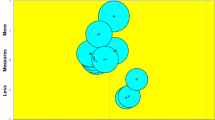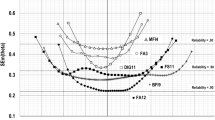Abstract
Objective
The present study was designed to validate the Hindi version of the Multidimensional Fatigue Inventory-20 (MFI-20) in Indian oncology population.
Methods
The original English version of the MFI-20 was translated into Hindi (hMFI-20) using the translation and back translation processes. The hMFI-20 was administered to 200 cancer patients. The item analysis for hMFI-20 was carried out using the corrected item-total correlation. The confirmatory factor analysis (CFA) was employed to test whether the original factor structure of MFI-20 is confirmed for the hMFI-20. Further, convergent and discriminant validities were also tested. The reliability of the hMFI-20 was evaluated by computing composite reliability and Cronbach’s α coefficient.
Results
Corrected item-total correlation value for each of the items of hMFI-20 was greater than 0.6. Results of the CFA (comparative fit indices (CFI) = 0.91, root mean squared residual (RMR) = 0.04, root mean square error of approximation (RMSEA) = 0.028, and χ 2 = 45.68, p > 0.05) indicated that the five-factor model provided a good fit to the data. The findings indicated that hMFI-20 has a good convergent (composite reliability (CR) >0.7; average variance extracted value (AVE) >0.5) and discriminant (maximum shared variance (MSV) < AVE; average shared variance (ASV) < AVE; square root of AVE > inter-factor correlations) validities. The Cronbach’s α coefficient for the total hMFI-20 was 0.8 and was more than 0.7 for each of the five factors.
Conclusions
We conclude that the hMFI-20 has a high internal consistency and reasonable construct validity. Therefore, the hMFI-20 is a reliable and valid tool to assess the multidimensional fatigue in Indian oncology population. However, we recommend further validation of hMFI-20 in population of cancer patients of different linguistic settings and regions of India.

Similar content being viewed by others
References
Smets EMA, Garssen B, Schuster-Oitterhoeve ALJ, De Haes JCJM (1993) Fatigue in cancer patients. Br J Cancer 68:220–224
Smets EMA, Garssen B, Cull A, de-Haesl JCJM (1996) Application of the multidimensional fatigue inventory (MFI-20) in cancer patients receiving radiotherapy. Br J Cancer 73:241–245. doi:10.1038/bjc.1996.42
Richardson A, Ream E, Wilson-Barnett J (1998) Fatigue in patients receiving chemotherapy: patterns of change. Cancer Nurs 21:17–30. doi:10.1097/00002820-199802000-00003
Richardson A (1998) Measuring fatigue in patients with cancer. Support Care Cancer 6(2):94–100. doi:10.1007/s005200050141
Schwartz AL, Nail LM, Chen S, Meek P, Barsevick AM, King ME, Jones LS (2000) Fatigue patterns observed in patients receiving chemotherapy and radiotherapy. Cancer Invest 18(1):11–19. doi:10.3109/07357900009023057
Lin CC, Chang AP, Chen ML, Cleeland CS, Mendoza TR, Wang XS (2006) Validation of the Taiwanese version of the brief fatigue inventory. J Pain Symptom Manag 32(1):52–59. doi:10.1016/j.jpainsymman.2005.12.019
Butt Z, Rosenbloom SK, Abernethy AP, Beaumont JL, Paul D, Hampton D, Jacobsen PB, Syrjala KL, Von Roenn JH, Cella D (2008) Fatigue is the most important symptom for advanced cancer patients who have had chemotherapy. J Natl Compr Canc Netw 6(5):448–455
Giacalone A, Polesel J, De Paoli A, Colussi AM, Sartor I, Talamini R, Tirelli U (2010) Assessing cancer-related fatigue: the psychometric properties of the revised piper fatigue scale in Italian cancer inpatients. Support Care Cancer 18:1191–1197. doi:10.1007/s00520-009-0741-0
Ryan JL, Carroll JK, Ryan EP, Mustian KM, Fiscella K, Morrow GR (2007) Mechanisms of cancer-related fatigue. Oncologist 12(1):22–34. doi:10.1634/theoncologist.12-S1-22
Stone P, Richards M, A’Hern R, Hardy J (2000) A study to investigate the prevalence, severity and correlates of fatigue among patients with cancer in comparison with a control group of volunteers without cancer. Ann Oncol 11(5):561–567. doi:10.1023/A:1008331230608
Annunziata MA, Muzzatti B, Mella S, Bidoli E (2013) Fatigue, quality of life, and mood states during chemotherapy in Italian cancer patients. Tumori 99(1):e28–e33. doi:10.1700/1248.13808
Curt GA, Breitbart W, Cella D, Groopman JE, Horning SJ, Itri LM, Johnson DH, Miaskowski C, Scherr SL, Portenoy RK, Vogelzang NJ (2007) Impact of cancer-related fatigue on the lives of patients: new findings from the fatigue coalition. Oncologist 5(5):353–360. doi:10.1634/theoncologist.5-5-353
Gupta D, Lis CG, Grutsch JF (2007) The relationship between cancer-related fatigue and patient satisfaction with quality of life in cancer. J Pain Symptom Manag 34(1):40–47. doi:10.1016/j.jpainsymman.2006.10.012
Appels A, Mulder P (1998) Excess fatigue as a precursor of myocardial infarction. Eur Heart J 9:758–764. doi:10.1093/eurheartj/9.7.758
Fawzy FI, Cousins N, Fawzy NW, Kemeny ME, Elashoff R, Morton D (1990) A structured psychiatric intervention for cancer patients. Arch Gen Psychiatry 47:720–725. doi:10.1001/archpsyc.1990.01810200037005
Lis CG, Rodeghier M, Grutsch JF, Gupta D (2009) Distribution and determinants of patient satisfaction in oncology with a focus on health related quality of life. BMC Health Serv Res 9:190. doi:10.1186/1472-6963-9-190
Pearson PG, Byars GE (1956) The development and validation of a checklist measuring subjective fatigue. Report: 56–115, Randolph Air Force Base, Tex.: Air University, School of Aviation Medicine, USAF
Smets EM, Garssen B, Bonke B, De Haes JC (1995) The Multidimensional Fatigue Inventory (MFI) psychometric qualities of an instrument to assess fatigue. J Psychosom Res 39:315–325. doi:10.1016/0022-3999(94)00125-O
Chang YJ, Lee JS, Lee CG, Lee WS, Lee KS, Bang SM, Wang XS, Mendoza TR, Cleeland CS, Yun YH (2007) Assessment of clinical relevant fatigue level in cancer. Support Care Cancer 15(7):891–896. doi:10.1007/s00520-007-0219-x
Hagelin CL, Wengström Y, Runesdotter S, Fürst CJ (2007) The psychometric properties of the Swedish Multidimensional Fatigue Inventory MFI-20 in four different population. Acta Oncol 46:97–104. doi:10.1080/02841860601009430
Tian J, Hong JS (2012) Validation of the Chinese version of Multidimensional Fatigue Inventory-20 in Chinese patients with cancer. Support Care Cancer 20:2379–2383. doi:10.1007/s00520-011-1357-8
Lin JS, Brimmer DJ, Maloney EM, Nyarko E, Belue R, Reeves WC (2009) Further validation of the Multidimensional Fatigue Inventory in a US adult population sample. Popul Health Metr 15(7):18. doi:10.1186/1478-7954-7-18
Gentile S, Delaroziere JC, Favre F, Sambuc R, San Marco JL (2003) Validation of the French Multidimensional Fatigue inventory (MFI 20). Eur J Cancer Care 12:58–64. doi:10.1046/j.1365-2354.2003.00295.x
Munguía-Izquierdo D, Segura-Jiménez V, Camiletti-Moirón D, Pulido-Martos M, Alvarez-Gallardo IC, Romero A, Aparicio VA, Carbonell-Baeza A, Delgado-Fernández M (2012) Multidimensional Fatigue Inventory: Spanish adaptation and psychometric properties for fibromyalgia patients. The Al-Andalus study. Clin Exp Rheumatol 30:94–102
Hsia J (2014) Probability sampling. Wiley StatsRef: Statistics Reference Online
Karnofsky DA, Burchenal JH (1949) The clinical evaluation of chemotherapeutic agents in cancer. In: MacLeod CM (ed) Evaluation of chemotherapeutic agents. Columbia University Press, New York, p 196
Mor V, Laliberte L, Morris JN, Wiemann M (1994) The Karnofsky performance status scale. An examination of its reliability and validity in a research setting. Cancer 53:2002–2007. doi:10.1002/1097-0142(19840501)53:93.0.CO;2-W
Hair J, Black W, Babin B, Anderson R (2010) Multivariate data analysis, 7th edn. Prentice-Hall, Inc, Upper Saddle River
Barrett P (2007) Structural equation modelling: adjudging model fit. Personal Individ Differ 42:815–824. doi:10.1016/j.paid.2006.09.018
Byrne BM (1998) Structural equation modeling with LISREL, PRELIS and SIMPLIS: basic concepts, applications and programming. Lawrence Erlbaum Associates, Mahwah
MacCallum RC, Browne MW, Sugawara HM (1996) Power analysis and determination of sample size for covariance structure modeling. Psychol Methods 1:130–149. doi:10.1037/1082-989X.1.2.130
Hu LT, Bentler PM (1995) Evaluating model fit. In: Hoyle R (ed) Structural equation modeling: concepts, issues, and applications. Thousand Oaks, Sage, pp 76–99
Nunnally JC, Bernstein IH (1994) Psychometric theory, 3rd edn. McGraw-Hill, New York
Holmes-Smith P, Cunningham E, Coote L (2006) Structural equation modelling: from the fundamentals to advanced topics. Sream and Statsline, Melbourne
Ghadi I, Alwi NH, Abu Bakar K, Talib O (2012) Construct validity examination of critical thinking dispositions for undergraduate students in university Putra Malaysia. High Educ Stud 2:138–145. doi:10.5539/hes.v2n2p138
Fornell C, Larcker DF (1981) Evaluating structural model with unobserved variables and measurement errors. J Mark Res 18:39–50. doi:10.2307/3151312
Kline RB (2005) Principles and practice of structural equation modeling, 2nd edn. The Guilford Press, New York
Cronbach LJ (1990) Essentials of psychological testing, 5th edn. Harper and Row, New York
Byrne BM (2010) Structural equation modeling with AMOS: basic concepts, applications, and programming. Routledge, New York
Bentler PM (2005) EQS 6 structural equations program manual. Multivariate Software, Encino
Lundh HC, Wengstrom Y, Runesdotter S, Furst CJ (2007) The psychometric properties of the Swedish Multidimensional Fatigue Inventory MFI-20 in four different populations. Acta Oncol 46:97–104. doi:10.1080/02841860601009430
Stein KD, Jacobsen PB, Blanchard CM, Thors C (2004) Further validation of the Multidimensional Fatigue Symptom Inventory-Short Form. J Pain Symptom Manag 27:14–23. doi:10.1016/j.jpainsymman.2003.06.003
Yusoff MSB (2011) Psychometric properties of the learning approach inventory: a confirmatory factor analysis. Educ Med J 3:e24–e31. doi:10.5959/eimj.3.2.2011.or3
Hafiz B, Shaari JAN (2013) Confirmatory factor analysis (CFA) of first order factor measurement model-ICT empowerment in Nigeria. Int J Busi Manag Adm 2:081–088
Bonham VL, Sellers SL, Woolford S (2014) Physicians’ knowledge, beliefs, and use of race and human genetic variation: new measures and insights. BMC Health Serv Res 14:456. doi:10.1186/1472-6963-14-456
Schwarz R, Krauss O, Hinz A (2003) Fatigue in the general population. Onkologie 26:140–144. doi:10.1159/000069834
Acknowledgments
This study was supported by the University Grants Commission, New Delhi, through its DRS-Special Assistance Program sanctioned to the School of Life Sciences, Pt. Ravishankar Shukla University, Raipur, in the thrust area “Chronobiology.” We are grateful to Prof. A.K. Pati, School of Life Sciences, Pt. Ravishankar Shukla University, Raipur, for the valuable suggestions and for reviewing the manuscript. We thank two anonymous reviewers for offering numerous constructive suggestions. We are thankful to all cancer patients for their voluntary participation in the present study.
Conflicts of interest
None of the funding source influenced the study design, collection, analysis, interpretation of data, and decision to submit the manuscript. We state that we have had full access to all the data in the study and that we agree to allow the journal to review our data if requested.
Disclosures
None
Author information
Authors and Affiliations
Corresponding author
Rights and permissions
About this article
Cite this article
Chandel, P., Sultan, A., Khan, K.A. et al. Validation of the Hindi version of the Multidimensional Fatigue Inventory-20 (MFI-20) in Indian cancer patients. Support Care Cancer 23, 2957–2964 (2015). https://doi.org/10.1007/s00520-015-2661-5
Received:
Accepted:
Published:
Issue Date:
DOI: https://doi.org/10.1007/s00520-015-2661-5




